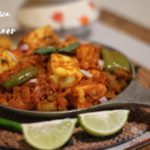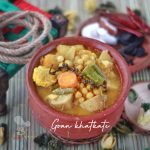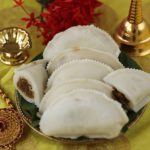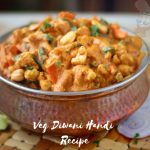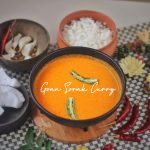Sunggle up in your favorite bamboo couch with a plate of hot steamed rice dunked in this Konkani kolambo with a lavish spread of cow's ghee.. Inhale the native smell of konkani kolambo that would soothe your senses with mixed flavors and relish it with a little bit of konkani history by reading the above article...
Table Of Contents:
- authentic Konkani Style Kolambo
- geographic Factors Of Konkani
- Language And Food
- A word On Its Gastronomy
- Marination- A Integral Part Of Konkani Cuisine
- Konkani Kolambo
- Essentials To Make Authentic Konkani Kolambo
- Step Wise Directions To Make Delicious Konkani Kolambo
- Nutritional Value
- Things To Consider
- Faqs
- Tantalizing Assortments
- Nature Of Konkani Kolambo
- Cozy Konkani
Konkani Kolambo originated from the Konkani belt in the Indian Subcontinent, much adored for its deliciousness and versatility. It is a fond dish popular all over the Konkan regions, and a karwar style of cooking which is mostly coconut based.
Geographical Factors Of Konkani:
The region Konkani refers to the thin strip of land in the west coast of India and this area falls between the river Damanganga in the north to the river kali to the south. The main land of konkan is in Maharashtra who speak Marathi and the other parts fall in coastal areas of Goa and Karnataka and a small region comes in the Northern part of Kerala. Due to many regional language influences, it has formed its own language in due course and this is how konkani language evolved.
Language And Food:
There are many local dialects and similarly there are different styles in konkani food and the major types are Malvani and karwar cuisines where the Malvani type is closer to Maharashtrian and the Goan styles whilst the Karwar cuisine has its influence from Kerala and Karnataka. This is the basic classification of Konkani food and it is marked by a lot of sea food, fiery and spicy dishes, coconut based gravies and recipes made of local grown vegetables and crops.
A Word On Its Gastronomy:
Konkani cuisine has the unique quality of being specific to its own cuisine which is not widely used or accepted in other cuisines generally. Innumerable varieties of sea food with authentic Indian seasoning mark the identity of Konkani cuisine which gives the originality to it. With rice and seafood being the basic staple,they use chicken, meat, all types of fishes, vegetables and of course a lot of coconut. It has a wide range of dishes starting from starters, appetizers to main course and desserts like any other cuisine but with its own individual style that results in the innovation of exmplary dishes.
Marination - An Integral Part Of Konkani Cuisine:
Konkani marinade is famous across the globe as it has spectacular specifications and procedures to follow apart from the choice of ingredients. The process is stunning and it forms the base of extraordinary outcome when it comes to enthralling starters and appetizers made of prawns, lobsters and fishes. Tamarind and lemon are the major ingredients to marinate, and in some dishes kokum is used to make it flavorful, soft and tender. Seasoning and garnishing are also given utmost importance and certain nuances are followed in adding the items at different stages and at definite proportions with specific intervals.
Vegetarianism is yet another section here and that is equally delectable and vast and you have umpteen number of delicious dishes in the list. Thy use a lot of raw mangoes, jaggery, triphla and kokum to spruce up the dishes and this particular konkani kolambo is a delicious vegetarian delight. Lentils, pulses and rice are quite popular and there are lots of dishes that are specifically coconut based including this konkani kolambo.
Konkani Kolambo:
It is a blend of lentil, veggies and spices that makes it nutritious and tasty as well. The kolumbo is made of tuvar dal and coconut paste acts as a base here and it is slicked up with some regular Indian spices which finally attains glory with a fantastic seasoning and garnishment. The native vegetables gives the authentic taste here and the heat of the cloves, red chili and other spices is balanced with the sourness of the tamarind. A lovely dish to muddle up your rice with and the best way to nourish your body. This dish is very much prefered during fasting or festival times as it is the most popular 'no onion no garlic ' recipe.
Here comes the recipe of Konkani Kolambo in its native style:
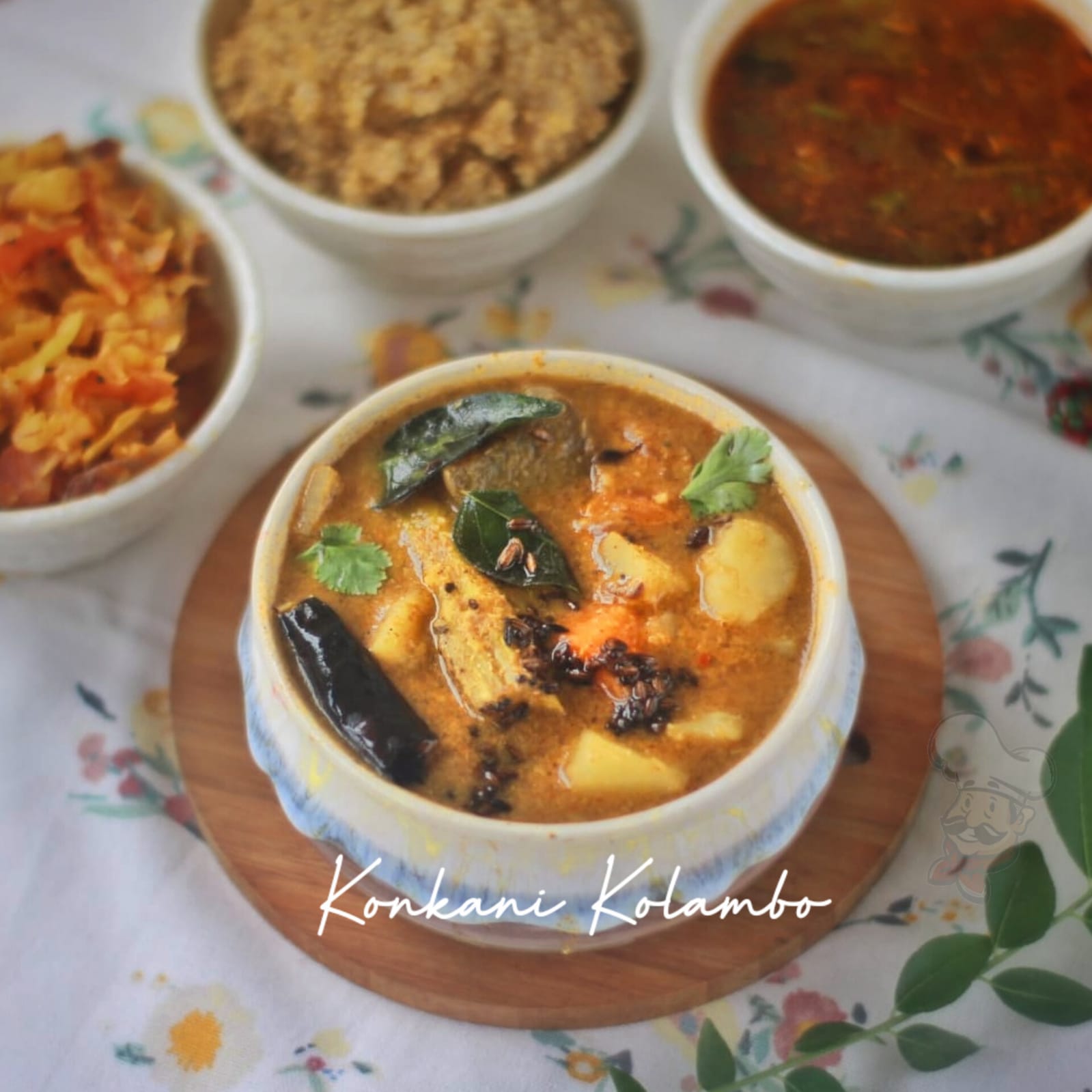
Ingredients Needed To Make Konkani Kolambo:
1. To Boil - tvar dal
2. To dry roast - grated coconut, red chili, coriander seeds, cumin seeds, urad dal, chana dal, cloves and fenugreek.
3. Vegetables - potato, carrot, french beans, cauli flower, drumstick, brinjal and tomato.
4. To Temper : coconut oil, mustard seeds, urad dal, curry leaves and asafoetida.
5. Add ons to make the kulambo: Turmeric powder and tamarind pulp.
Step wise directions To Make Konkani Kolambo:
1. Boil : Boil a cup of tuvar dal until mushy.
2. Dry Roast : Dry roast the given ingredients and blend it to a smooth paste.
3. Boil The Veggies: Par boil the veggies with minimum water and salt.
4. Make The kolambo: Add the coconut paste and veggies to the dal with some tamarind and turmeric powder.
5. Temper: Do the tempering with regular Indian condiments and add it to the kolambo.
6. Serve Hot : Serve it with hot steamed rice and potato fry.
Drop in a cup of tuvar dal in a vessel and add one and a half cup of water to it and pressure cook for three to four whistles and keep aside. Let it cool for a while.
Heat a small saucepan and drop in the above mentioned ingredients one by one and dry roast in order until it becomes fragrant. After five minutes, drop in all the roasted ingredients to a blender and splash in a little water and make a smooth paste out of it.
Pour in two cups of water in a skillet and boil. Add the measured quantities of the veggies mentioned and tip in a pinch of salt and let it boil for about five minutes approximately. Turn off the heat and strain the parboiled veggies in a colander.
Heat the pressure cooker again with the boiled dal and just mash up with a masher to make it smooth and even. Drop in the parboiled veggies to it and add the required salt.
Tip in a pinch of turmeric powder and plop in the spice masala paste to it with a nice stir. Add the required amount of vegetable strained water to dilute the consistency and adjust the flame to medium mode. Let it boil for a while until the whole mixture gets cooked up completely. Squirt in a tablespoon of tamarind pulp and stir well. Let it continue to boil in medium flame for some time.
When it reaches the desired consistency and turns aromatic, just lower the flame.
Heat the saucepan again and drizzle a little oil and when it is heated scatter some mustard seeds and when it pops up, throw in a dried red chili, some broken urad dal and a sprig of curry leaves. Let it sizzle too. At last tip in a tiny bit of asafoetida (soild) and saute. Just after a second or two, turn off the flame and drop in the sauteed ingredients to the kolumbo with the crackling noise.
Serve hot with raw rice topped up with a dash of ghee along with a papad.
Things To Consider:
- Usually konkani kolambo is reasonably thin while compared to other south Indian kuzhambu varieties and it tastes delicious that way.
- Potato is the key ingredient here and never miss out on this. Even cauli flower stems are flavorful and can slick up the kolambo to a greater extent.
- Ivy gourd and yam are also added in some versions of konkani kolambo.
- While boiling the veggies, do not cook it in the pressure cooker along with the tuvar dal , as it would get mushy altogether.
- While boiling the veggies in an open vessel, add the veggies one by one according to their texture. Add the hard ones first and the soft ones at last so as to retain it crunchy and tasty besides holding its nutrients as well.
- Finally, when the tempering is over just sprinkle some chopped cilantro and pop the lid on until you serve to arrest the aroma.
Faqs:
What is the difference between konkani Kolambo and the regular South Indian sambhar?
Ans: Though it may appear similar to that of sambhar, actually they are not. Kolambo has a lot of mixed vegetables and spices when compared to sambhar. You may or may not add spicy coconut paste in sambhar whilst you cannot make Konkani kolambo without the coconut base. The consistency is quite thinner and the color too varies from each other. Tempering is done in coconut oil in kolambo whereas sesame oil or ground nut oil is used in sambhar mostly.
Tantalizing Assortments:
1. Brinjal phodi
2. rice
3. idli, dosa
4. shallow fried potato talasani
5. carrot talasani
Konkani Kolambu is:
1. native style
2. spicy and flavorful
3. full of veggies
4. light red colored
5. dal based
6. fresh smell of coconut
7. versatile
8. quick and easy to make
9. contains seasonal vegetables
10. flowy consistency
Cozy Konkani:
It is not everyday that you are going to throw in a konkani food fiesta, and therefore you need to bring out the feel of it with a perfect ambience that would suit the food. If the dishes have a fusion of both the vegetarian and the non vegetarian, to make it exotic lets start with crispy bombil fry as starters. With rice as the main dish, we can have this lip-smacking konkani kolambo along with ivy-gourd gojju, vaingana phodi, airavat and sol kadhi as a delectable drink in between. This would suffice for a midday brunch party and you can offer kelya ambat or sheer as dessert as a divine indulgence.
Ingredients
Directions
Drop in a cup of tuvar dal in a vessel and add one and a half cup of water to it and pressure cook for three to four whistles and keep aside. Let it cool for a while.
Heat a small saucepan and drop in the above mentioned ingredients one by one and dry roast in order until it becomes fragrant. After five minutes, drop in all the roasted ingredients to a blender and splash in a little water and make a smooth paste out of it.
Pour in two cups of water in a skillet and boil. Add the measured quantities of the veggies mentioned and tip in a pinch of salt and let it boil for about five minutes approximately. Turn off the heat and strain the parboiled veggies in a colander.
Heat the pressure cooker again with the boiled dal and just mash up with a masher to make it smooth and even. Drop in the parboiled veggies to it and add the required salt.
Tip in a pinch of turmeric powder and plop in the spice masala paste to it with a nice stir. Add the required amount of vegetable strained water to dilute the consistency and adjust the flame to medium mode. Let it boil for a while until the whole mixture gets cooked up completely. Squirt in a tablespoon of tamarind pulp and stir well. Let it continue to boil in medium flame for some time.
When it reaches the desired consistency and turns aromatic, just lower the flame.
Heat the saucepan again and drizzle a little oil and when it is heated scatter some mustard seeds and when it pops up, throw in a dried red chili, some broken urad dal and a sprig of curry leaves. Let it sizzle too. At last tip in a tiny bit of asafoetida (soild) and saute. Just after a second or two, turn off the flame and drop in the sauteed ingredients to the kolumbo with the crackling noise.
Serve hot with raw rice topped up with a dash of ghee along with a papad.


